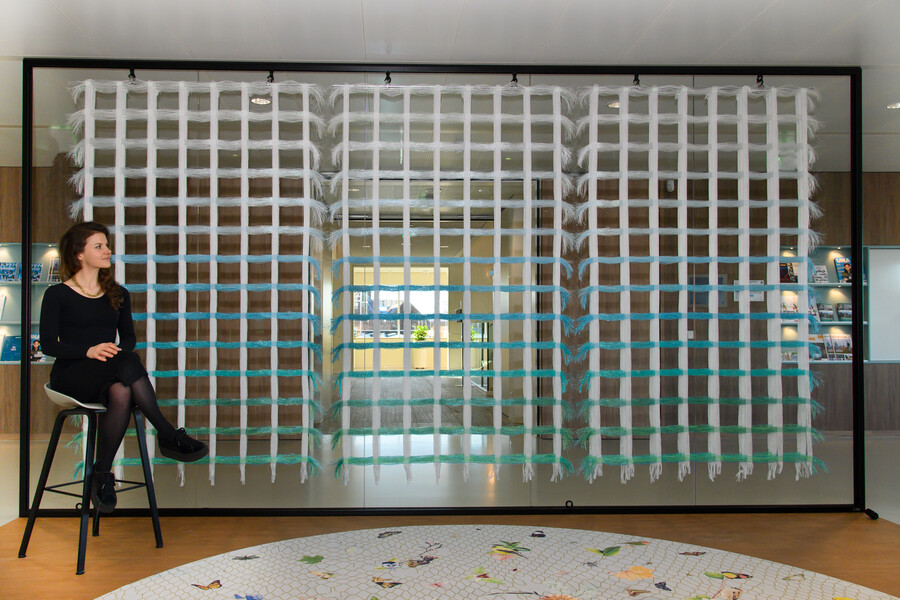In collaboration with the TextielLab, the City of Tilburg asked seven young makers to create a work of art for the new city hall. Fransje Gimbrère was one of them: “It was a long-held wish of mine to investigate whether I could make my 3D work on an industrial loom in the lab.”
Tilburg’s city hall was fairly empty the first year after completion because of corona, but the civil servants recently returned to the completely renovated building. With their return, the works by seven young Brabant artists have finally come into their own. The transparent textile dividing walls on different floors were commissioned by Marcelle Hendrickx, alderman for culture, who believes that investing in art should be a natural part of urban development. “Investing a fixed percentage in art should be a regular part of the commissioning process in projects like this. Because art affects you. Art communicates. And you can see that in our city hall too: being surrounded by beauty makes people happier and more productive.”
Transparent dividing wall
With Hebe Verstappen, the head of the TextielLab, the municipality selected seven young local makers. Larissa Schepers, Tamara van Roij, Alissa + Nienke, Robin Pleun Maas, Wouter Paijmans, Vera de Pont and Fransje Gimbrère were asked to make a work that functions as a transparent dividing wall in the lobby of a different floor. The pieces were largely developed in the TextielLab. “We were given a lot of freedom in completing the commission,” says Fransje Gimbrère. She had already made her mark in the city hall with ‘Cirrus’, a hand-woven 3D structure that floats above the round meeting tables in the brand-new Council Chamber like a white cloud. She wanted this new commission to connect with that design but using a completely different process. “It was a long-held wish of mine to investigate whether I could make my 3D structures on an industrial loom in the TextielLab.”

Fransje Gimbrère in front of her design for the dividing wall. Photo: Ton van Rooij
Good progress
She says the three development days she spent in the lab were too short to elaborate her entire idea but long enough to make good progress in her technical and material research. “Stef Miero, master weaver in the TextielLab, immediately warned me about the feasibility of my plan but was open to my vision. I really enjoyed working with him.” Together they took on the challenge of weaving three layers simultaneously with the aim of creating not only real depth but also large openings of 12 square centimetres in a two-dimensional surface. Using a linen weave, in which the warp and weft alternately lie above and below each other, they found a way to fix all the threads in the right place in an extremely loose fabric. This weave gave the work its name: ‘Linum’. “I would have preferred to make everything from flax, the raw material linen is made from, but that wasn’t feasible,” says Gimbrère. The warp is white cotton, and the weft is a mix of materials and colours. “I think I ended up using all the yarns in the lab!”
“It was a long-held wish of mine to investigate whether I could make my 3D structures on an industrial loom in the TextielLab.” – Fransje Gimbrère
Tilburg University
Over the year, unique works of art gradually appeared in the seating area on each floor of the city hall. ‘Linum’ was installed on the third floor in November: an airy framework of three panels with a depth of 10 centimetres and a colour gradient that runs from blue to green. The shape, colour and material complement the Moooi carpet in the same area, the lamps in the kitchen and the other furnishings in the space. At the same time, ‘Linum’ refers to the artwork in the Council Chamber on the other side of the building. Gimbrère is pleased with the result. “The three panels each consist of a further three panels, which are woven over and onto each other, as it were. As a result, the work has become a real 3D object that interacts with the space.” Both she and Miero are keen to research the same technique further, an opportunity that has already arisen thanks to a new project for Tilburg University. “The project for the city hall was a good first taste, and now I want more. I like pushing not only my own limits but also the limits of the machine. And I think there’s a lot more we can still do.”